How to treat roses for black spot: preventive measures and treatments
So, black spots appeared on your wonderful roses, right? Indeed, black spot is one of the most common rose diseases that most flower growers face. (about like late blight of potatoes andtomato, apple and pear scab or mildew grape).
Next, you will learn how to treat roses for black spot, what to do and what to spray (with what fungicidal preparations) if black spots appear on the leaves of your garden queen.
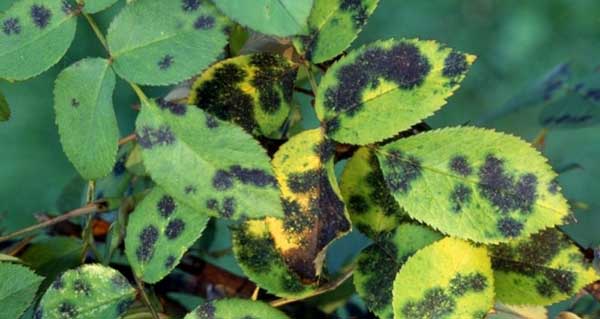
Content
What is black spot of roses: reasons, when and how it manifests itself
This disease causes a fungus Marssonina rosae.
The fungus hibernates on leaves and shoots, as well as in the soil, more precisely, in plant debris (in the same fallen leaves). In spring, spores spread through the garden along with winds and rains (+ fogs).
As a rule, fungal spores infect the plant at the beginning of the season, i.e. in spring and early summer (under favorable conditions), however, the first signs of the disease appear only in the second half of summer (July-August).
Marsonia (Marssonina) = black spot (many are used synonymously).
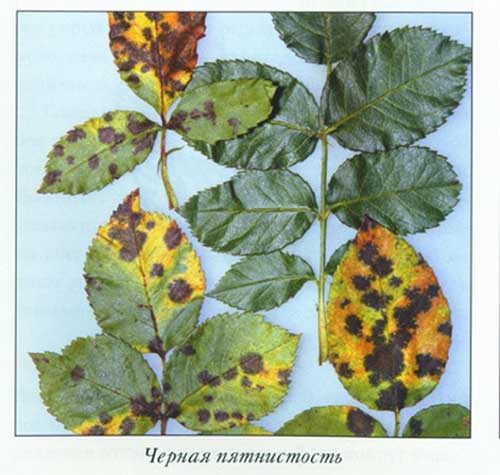
What does the lesion of rose leaves look like with black spot?
- As a rule, leaves that are closer to the soil (i.e. below) are affected first. Round or "blot-like" (with wavy edges) black spots appear on them, and these spots can be observed both from the outside and from the inside of the sheet. Over time, black spots begin to appear on the upper leaves.
- Then they gradually merge and turn yellow, dry and fly around.
Note! There are other causes of yellowing and falling leaves of roses.
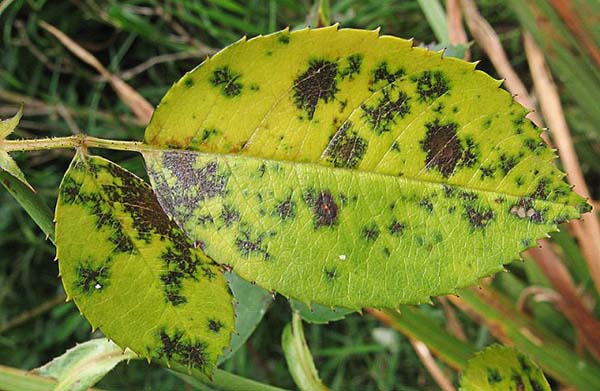
Favorable conditions for the development of the disease:
- wet rainy weather;
- cold nights (strong fluctuations in night and day temperatures) and morning dew;
- evening watering, when the roses do not have time to dry.
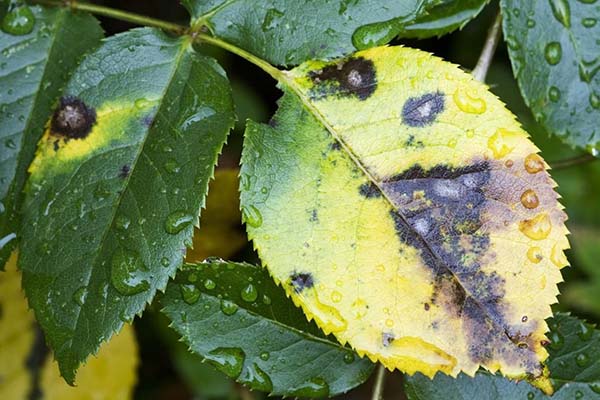
In other words, if summer is wet and cold (it often rains and the nights are cool), then black spots will definitely appear on the leaves of your roses, if you do not take preventive measures to protect them.
Also, the site of planting, more precisely, an unfavorable microclimate, also affects the defeat of black spot and other fungal diseases. So, in lowlands and poorly ventilated areas of the garden, dew is more often formed at night.
Remember! Roses need to be planted in sunny and well-ventilated places, while not too close, so that there is no thickening. It is also very desirable that the place be illuminated in the morning by the sun, which will dry out the morning dew.
What is the danger of black spot for roses?
- Slightesttouch to infected leaves causes themsinking.
- If there is a strong infection of the bushes, then by the end of summerthe plant is completely bare, i.e. will be left without leaves.
- As a result, the rose will not only lose any decorative effect, but due to the weakening of immunity (due to the absence of leaves) the plant may simply freeze out in winter (or at least it is bad to endure the winter, grow poorly and bloom in spring).
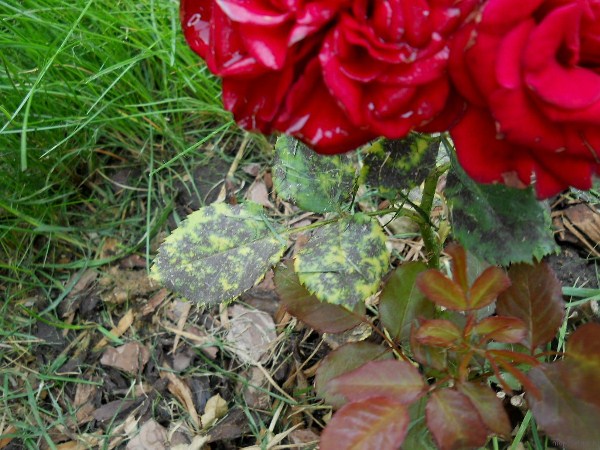
Prevention of black spot of roses
To minimize the possibility of the appearance of black spots on roses, the following preventive measures (agronomic techniques) can be applied:
- First, select healthy and strong seedlings, and then plant them correctly (in a sunny place and at a sufficient distance).
By the way! The site has detailed articles on how when and how to plant rose seedlings in spring and in the fall.
- Inspect the plants regularly throughout the growing season, i.e. from early spring to autumn (up to shelter for the winter), to pick off and burn all suspicious (infected) leaves with spotssince spores of the fungus overwinter in fallen leaves.
- In the spring it is imperative to conductintensive pruning of roses, and it follows remove all thin and weak shootssince they are the first to be hit.
- Since this disease, like other fungal diseases, develops very well in a humid environment, do not be zealous with sprinkling, though roses love them. It is better not to wet the foliage at all and water it only in the morning, so that by the evening the surface layer of the soil dries up.
- Right feed in spring and summer, and in the fall... Special do not overfeed with nitrogen, a apply potash fertilizers more often (for example, the same wood ash).
- Including periodically spraying with immunostimulants (growth stimulants), for example, Epin, Zircon, HB-101.
- Correctly prepare roses for winter, namely in autumn remove all fallen leaves, pick off those that have not flown, and cut out all diseased shoots (carry out autumn pruning) and necessarily spray in front of shelter iron vitriol.
By the way! Rosehip can become a breeding ground for all kinds of rose diseases, so it is better not to keep it in your area.
However, if the observance and implementation of the above preventive measures did not give an effect and black spots still appeared on the leaves of the roses, then you need to immediately start spraying roses with special fungicides in order to stop the further spread of the disease.
Moreover, if you know that there is a real danger of damage to your bushes with black spot (you have a very susceptible variety and / or favorable conditions have been created for the development of the disease), then better start to carry out preventive spraying in advance, and not rush to treatwhen the leaves have already turned yellow and black spots have formed on them.
Resistant varieties
Unfortunately, there are no varieties that are completely resistant to black spot. There are more receptive, there are less.
In other words, if you do not want to fight fiercely with black spot, then you need to plant the most resistant varieties, among which the following are distinguished:
- Apache (Apache);
- Chopin (Chopin);
- Concerto 94 (Concerto 94);.
- Maritim;
- Cherry Girl;
- as well as roses of German selection Kordes and Tantau and many others. others.
Note! In the catalogs of the German company "Kordes" near the word "sternrusstau" (with German - black spot), 3 stars are drawn, which indicate the degree of resistance of a rose to black spot: how many of them are completely painted over, such is the resistance of the variety to emergency (black spot).
Video: roses without black spot are the most resistant varieties
How to properly spray roses from black spot and other diseases
If you want your treatments to be effective, you must know and follow the basic rules for using fungicides:
- In the spring (before flowering), as a rule, drugs of a preventive (protective) action are used, and in the summer (during the flowering period) in case of a disease, a therapeutic (protective-therapeutic) action is used.
It makes no sense to fight the disease with prophylactic (protective) means.
- It is better to use funds with different active ingredients (alternate) so that there is no addiction (resistance).
Note! Powdery mildew control may not work against black spot, and vice versa. But they usually work.
- It is necessary to spray in cloudy, but not rainy weather.
The frequency of treatments depends on the drug and the weather. Namely, if this is a contact agent (for example, copper-containing), then the treatments must be repeated after each rain (at least once every 7-10 days), if systemic (penetrates into the plant and is not washed off by the rain), then after 2-4 weeks.
- You need to spray thoroughly, both the outer and inner sides of the leaf.
If there are a lot of rose bushes and you do not have time to pick off diseased leaves, then you can work directly on them, but it is better, if possible, to get rid of infected leaves.
- Treatments can and should be carried out during the flowering period, and the buds can also be sprayed.
Important! Do not wait for "recovery" of already diseased leaves. They will eventually fall off, but new ones will quickly grow in their place.
How to treat roses from black spot: the best remedies
The following fungicidal preparations, according to gardeners' reviews, are really effective against black spot (the active substance and the nature of the effect are indicated in brackets).
Chemical fungicides
Triazole based:
- Tilt (Propiconazole, systemic fungicide protective and healing actions);
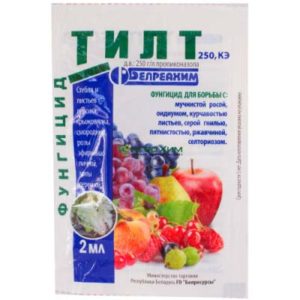
- Forecast (Propiconazole);
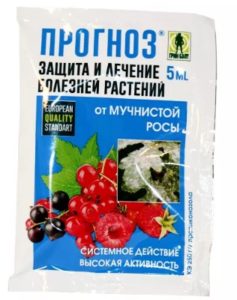
Tilt and Forecast are drugsanalogs, which the same active ingredient - Propiconazole.
There are also other analogues:
- Chistoflor (Propiconazole);
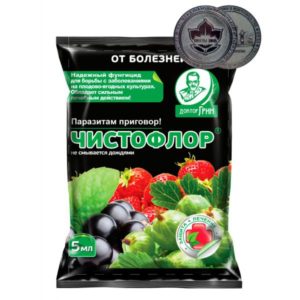
- Agrolekar (Propiconazole);

- Scor (Difenoconazole, a systemic fungicide of protective and curative action, against black spot, powdery mildew);
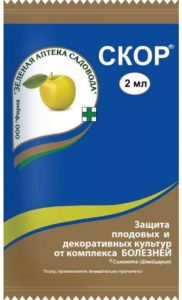
- Raek (Difenoconazole);
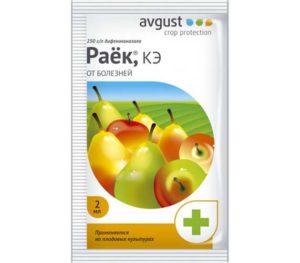
- Store (Difenoconazole).
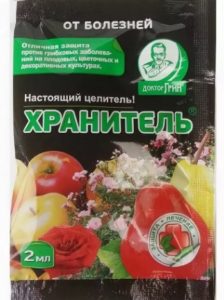
Skor, Raek and the Guardian are preparations-analogs, which the same active ingredient - Difenoconazole.
- Topaz (Penconazole (Topaz), systemic protective fungicide action guaranteed against powdery mildew and rust).
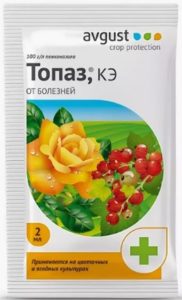
- Falcon (Spiroxamine, Tebuconazole, Triadimenol (Baytan), a systemic fungicide of protective and curative action);
Containing Mancozeb - Ridomil Gold (Mancozeb and Mefenoxam), contact-system fungicide protective and healing actions).
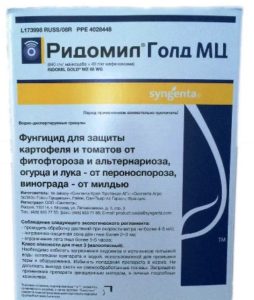
Drugs copper based — Bordeaux liquid, copper sulfate, Abiga-peak, Hom and Oxyhom.
Biological product: Fitosporin-M.
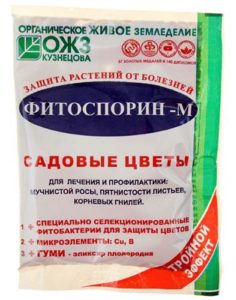
Folk remedies (soda)
Spraying with soda solutions gives a good effect.
- For example, you can simply make a 0.5-1% solution (5-10 grams per liter of water) of baking soda.
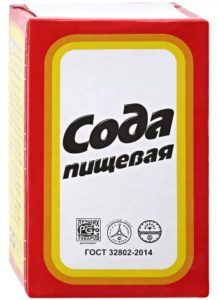
Recipe from Procvetok Channel
For the prevention of the occurrence and for the treatment of roses already sick with black spot, the following solution can be used.
Ingredients:
- 5 liters of water;
- 25 ml of an alcohol solution (2%) of salicylic acid (can be increased to 50 ml);
- 1 tbsp. a spoonful of ammonia (10% ammonia solution);
- it is also advisable to add a tablespoon of liquid soap to better wet the surface of the leaves.
Advice! First dissolve salicylic acid in a small amount of warm water (40-45 degrees) and only then bring to the final volume!
Recommendations for use:
- During periods of vulnerability, plants can be treated weekly. As a rule, 3-4 treatments are enough.
- The recipe is suitable for all plants to strengthen the immune system, as well as for the treatment of delphiniums, phlox, currants, gooseberries from powdery mildew.
Video: pharmacy cure for all rose diseases
Thus, now you know what the Marsonia mushroom (= black spot of roses) is, when and how this disease manifests itself, what to do, what preventive measures to take to minimize the damage.
Opinion: “It is impossible to eliminate black spot. You can only select varieties that are resistant to this disease, and regularly fight by spraying. "
Video: black spot on rose leaves - prevention and treatment

